Embark on a culinary adventure to the heart of Thailand with our enticing Thai chili paste, Nam Prik Pao. This beloved condiment isn't just a recipe; it's a gateway to Southeast Asia's vibrant street food culture and rich flavors. Imagine the intoxicating aroma of roasted chilies and garlic mingling with the subtle sweetness of palm sugar, all bound together with the umami depth of shrimp paste. Whether you're a spice enthusiast or a curious foodie, this recipe promises to transport your taste buds to bustling Thai markets where each spoonful tells a story of tradition and innovation. Get ready to elevate your dishes with authentic Thai magic and discover why Nam Prik Pao has captured hearts and palates worldwide.
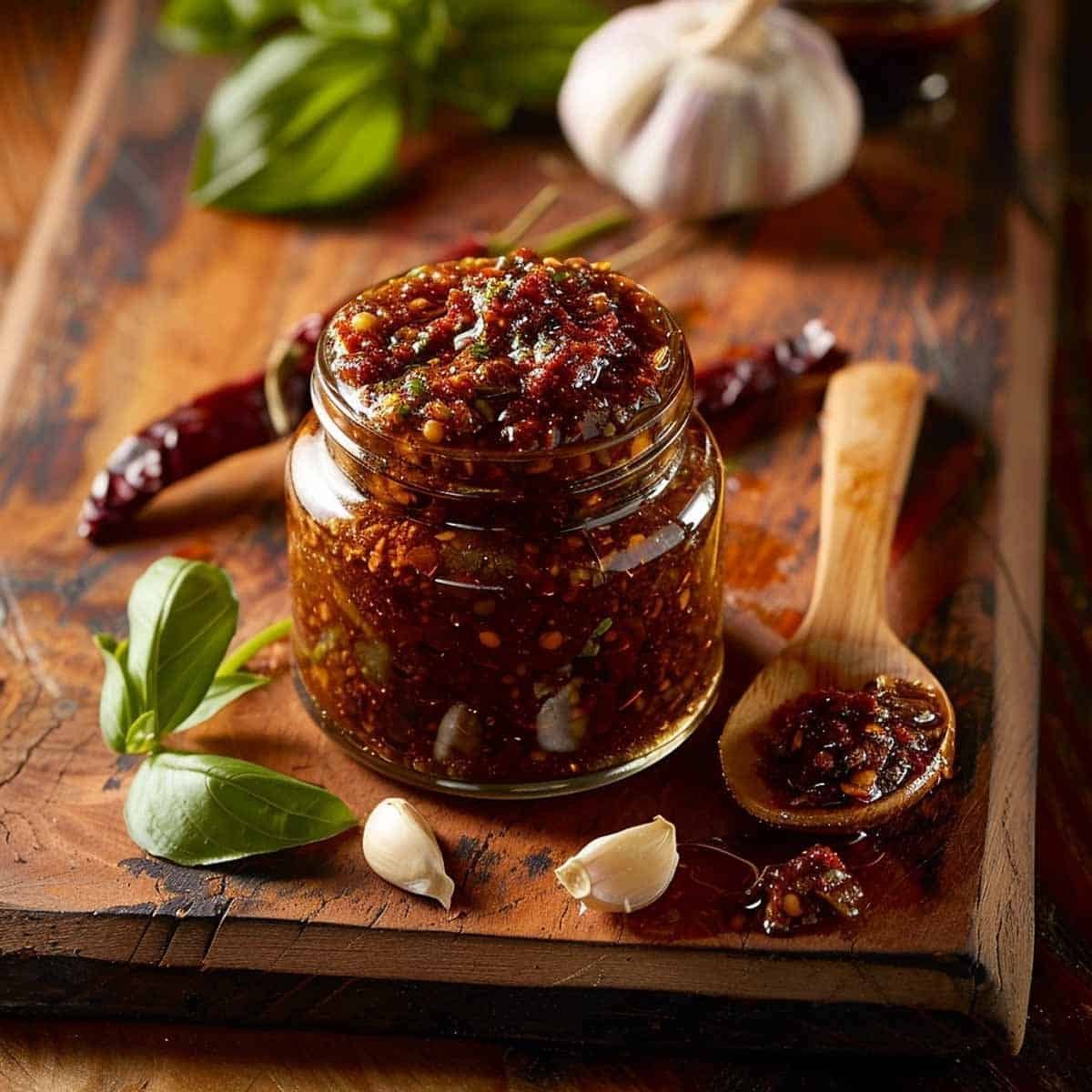
The origins of Nam Prik Pao trace back to Thailand's culinary heritage, where the art of chili pastes dates back centuries. This fiery condiment, revered for its robust flavor profile, embodies the essence of Thai cuisine—a harmonious balance of spicy, sweet, and savory notes. Traditionally crafted from sun-dried chilies, garlic, and shrimp paste, it reflects the resourcefulness of Thai cooks in maximizing local ingredients. Over time, Nam Prik Pao has become a cornerstone of Thai gastronomy, enriching everything from stir-fries to soups and even noodle dishes. Its versatility and depth of flavor have made it a staple in home kitchens and professional settings, transcending borders to become a beloved global favorite. Explore the cultural tapestry woven into every jar of Nam Prik Pao and unlock the secrets behind its enduring allure.
Pairing Suggestions and Side Dishes:
- Steamed Jasmine Rice: The neutral, fluffy texture of jasmine rice serves as the perfect base to absorb the bold flavors of Nam Prik Pao, creating a satisfying and comforting meal.
- Grilled Chicken Skewers: The smoky char from grilled chicken complements the smokiness of the chili paste, while the tender meat balances the dish's heat with its mild flavor.
- Stir-Fried Vegetables: Crisp, vibrant vegetables stir-fried with Nam Prik Pao absorb its flavors, offering a refreshing contrast and adding nutritional value to the meal.
- Pad Thai Noodles: The sweet and sour notes of Pad Thai noodles harmonize with the spicy and savory flavors of Nam Prik Pao, creating a delightful fusion of Thai tastes.
Wine Pairings:
- Riesling: Its sweetness offsets the spiciness of Nam Prik Pao, while its acidity enhances the dish's tangy elements.
- Pinot Noir: This light red wine complements the dish's complexity with its fruity notes, balancing the spice without overwhelming it.
- Sauvignon Blanc: Crisp and citrusy; Sauvignon Blanc refreshes the palate between bites of Nam Prik Pao, enhancing its herbal and tangy components.
Beer Pairings:
- Leo Super, Singha, and Chang: These Thai lagers complement Nam Prik Pao's spicy profile with crisp, refreshing qualities. Their light body and balanced bitterness cleanse the palate, making each bite of the chili paste more enjoyable.
Embark on a new culinary adventure right from your kitchen.

Sawasdee Kha, (Hello)
I'm thrilled to share a piece of Thai culinary heritage with you. This Nam Prik Pao recipe holds a special place in my kitchen for several reasons:
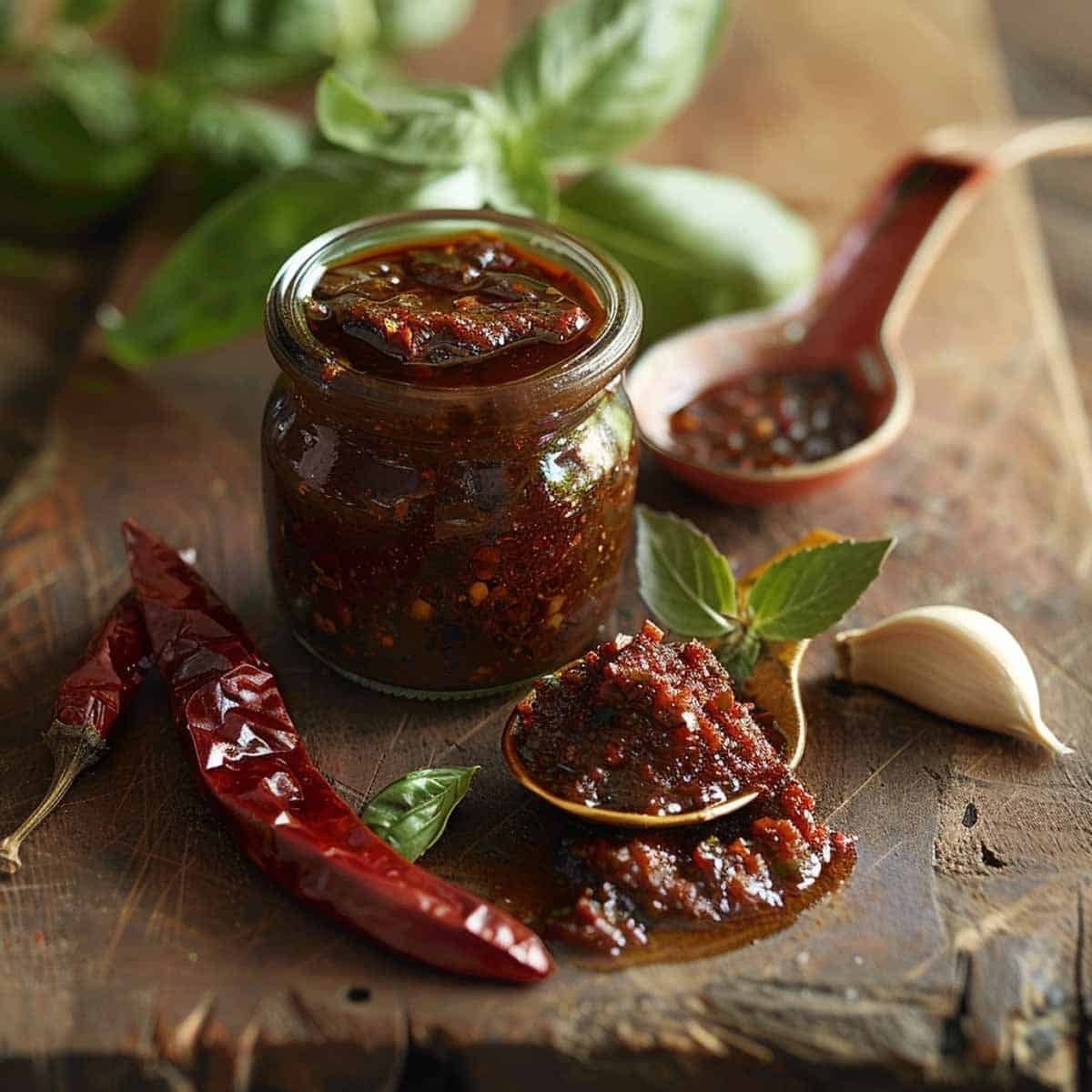
- Flavor Complexity: The combination of dried chilies, shallots, garlic, shrimp paste, tamarind, fish sauce, and palm sugar creates a rich, complex flavor that is both unique and deeply satisfying.
- Versatility: This paste can be used in a variety of dishes, adding depth and a burst of authentic Thai flavor to anything from stir-fries to soups and even as a condiment.
- Homemade Freshness: Making this paste at home ensures the freshest ingredients and allows me to control the quality and balance of flavors, resulting in a superior taste compared to store-bought versions.
I really hope you enjoy making and savoring this dish as much as I do!

WELCOME TO MY HOUSE! COME MAKE THIS NAM PRIK PAO (Thai roasted chili paste) WITH ME!
Ingredients for Thai Chili Paste
Let's dive into the fantastic ingredients in Nam Prik Pao. This Thai roasted chili paste is brimming with bold flavors. It features dried Thai chilies for that perfect kick, shallots garlic for a rich, aromatic base, and a mix of tamarind paste and palm sugar that adds a delightful tang and sweetness. Toss in some umami-packed shrimp paste and fish sauce, and you have a condiment that elevates the dish it touches. It's a simple yet spectacular blend that brings the essence of Thai cuisine right into your kitchen!
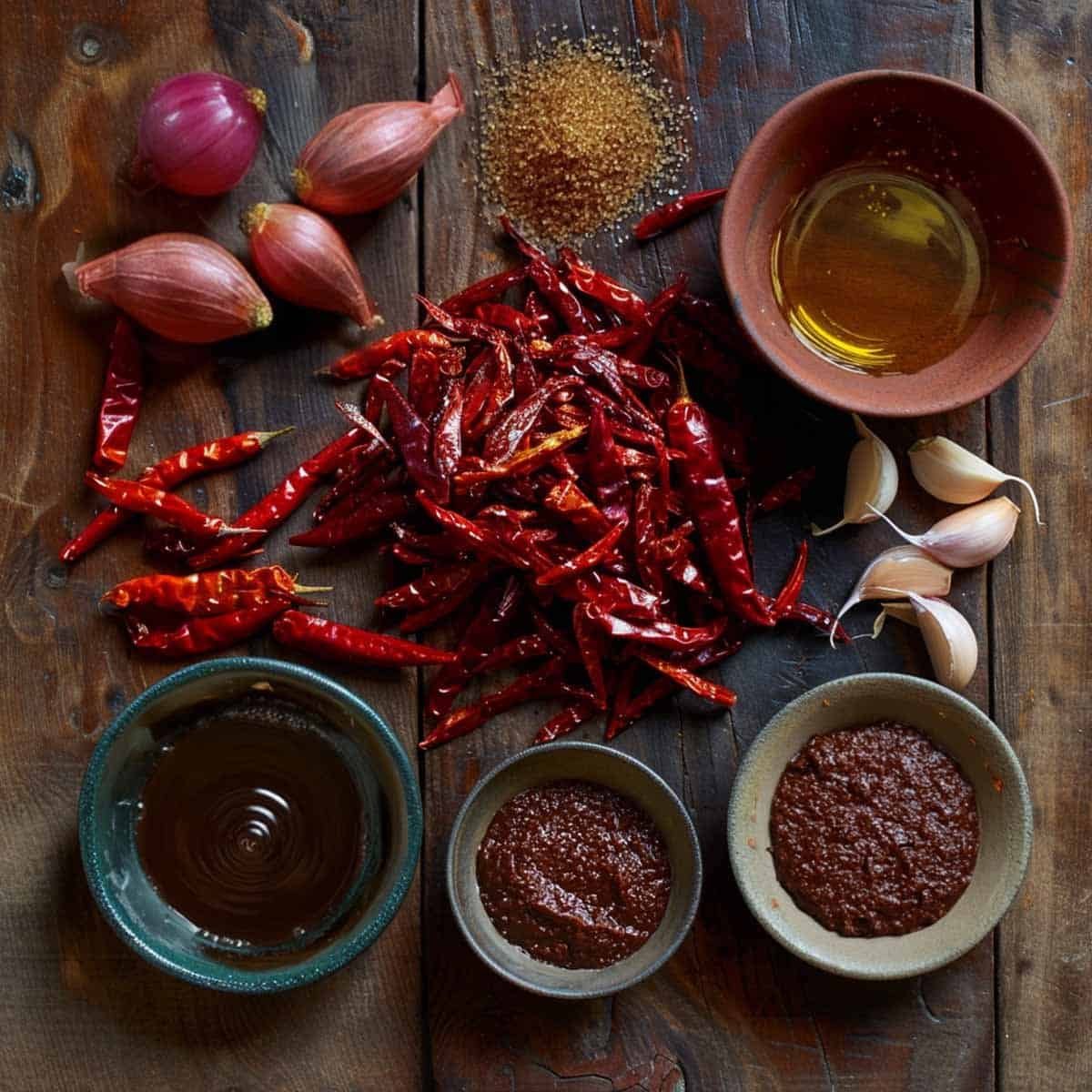
- Dried Thai chilies provide the robust heat essential to the paste's character.
- Shallots add subtle sweetness and depth, enhancing the richness.
- Garlic, known for its spicy aroma and flavor, rounds out the paste with its robust taste.
- Shrimp paste contributes an irreplaceable umami flavor, giving the paste a distinct Thai profile.
- Tamarind paste adds a sour note, balancing the sweetness and heat of the other ingredients.
- Fish sauce brings saltiness and additional umami, amplifying the paste's complexity.
- Palm sugar offers a mild sweetness, effectively contrasting the chilies' heat and tamarind's tartness.
- Vegetable oil is used for frying the ingredients, a crucial step that melds the flavors and adds a silky texture to the paste.
It introduces a mild sweetness, which beautifully contrasts with the chilies' heat and the tamarind's tartness.
See the recipe for actual quantities.
Preparing the ingredients for Nam Prik Pao
Prepare the ingredients for Nam Prik Pao by first soaking the dried chilies in warm water to soften them, making them easier to blend later. While the chilies soak, peel and thinly slice the shallots and garlic. This ensures they cook evenly and infuse the oil with their rich, aromatic flavors when fried. This initial preparation lays the groundwork, creating a foundation for a smooth cooking experience and leading to a deliciously complex chili paste.
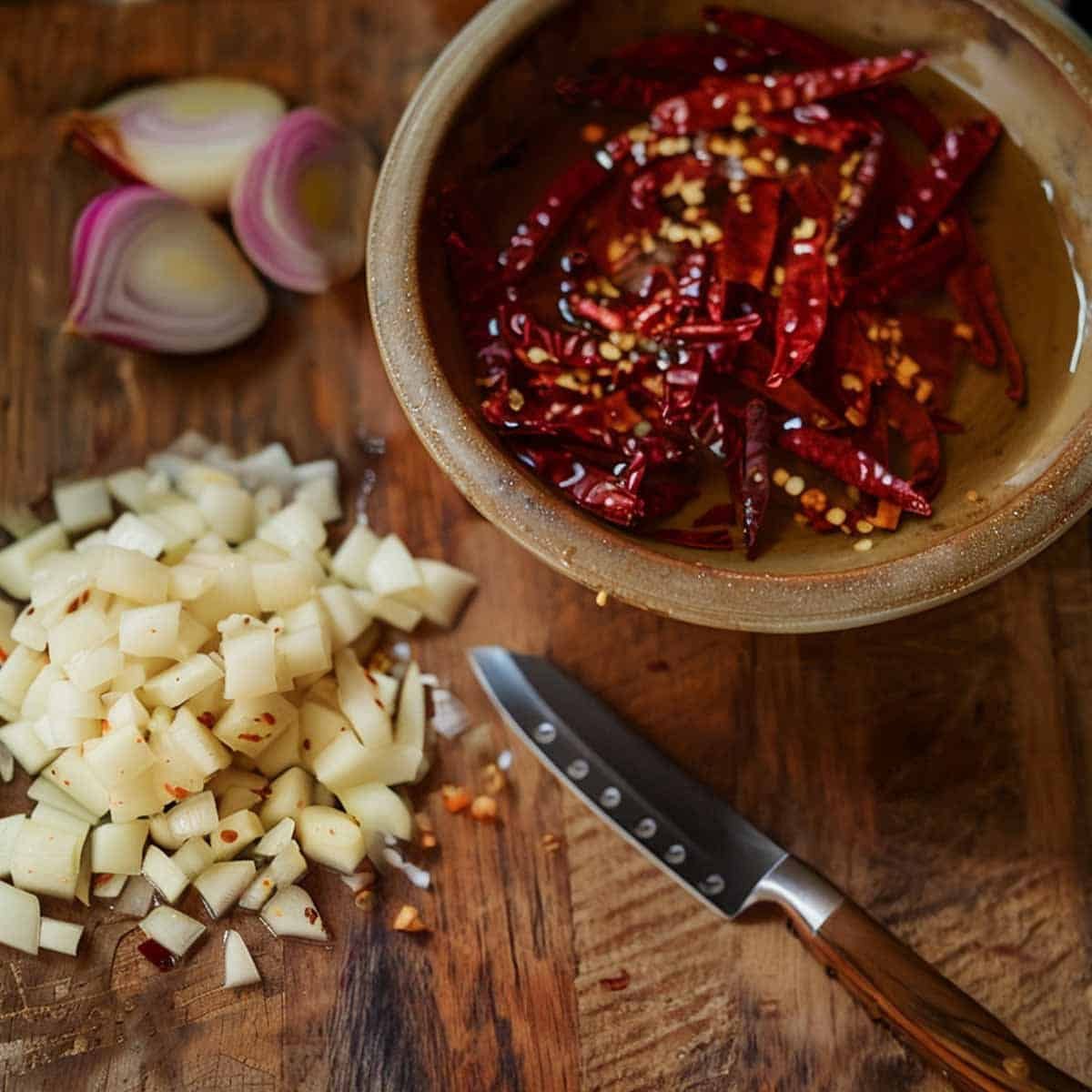
Roasting ingredients for Nam Prik Pao:
In these essential steps for making chili paste, start by heating a small amount of vegetable oil in a frying pan over medium heat. Add thinly sliced shallots and garlic to the hot oil, frying them until they turn golden and crispy. Once done, carefully remove them and let them drain on a paper towel to remove excess oil. Following that, use the same flavorful oil to fry the pre-softened chilies. Fry them until they darken and achieve a crispy texture, then remove and drain similarly. These steps are crucial for developing the deep, aromatic flavors that define this traditional Thai chili paste.

Making Nam Prik Pao:
In making Nam Prik Pao, the process involves grinding fried chilies, shallots, and garlic into a paste, then adding shrimp paste, tamarind paste, fish sauce, and palm sugar. Blend until smooth to create the essential complex flavor of Nam Prik Pao.
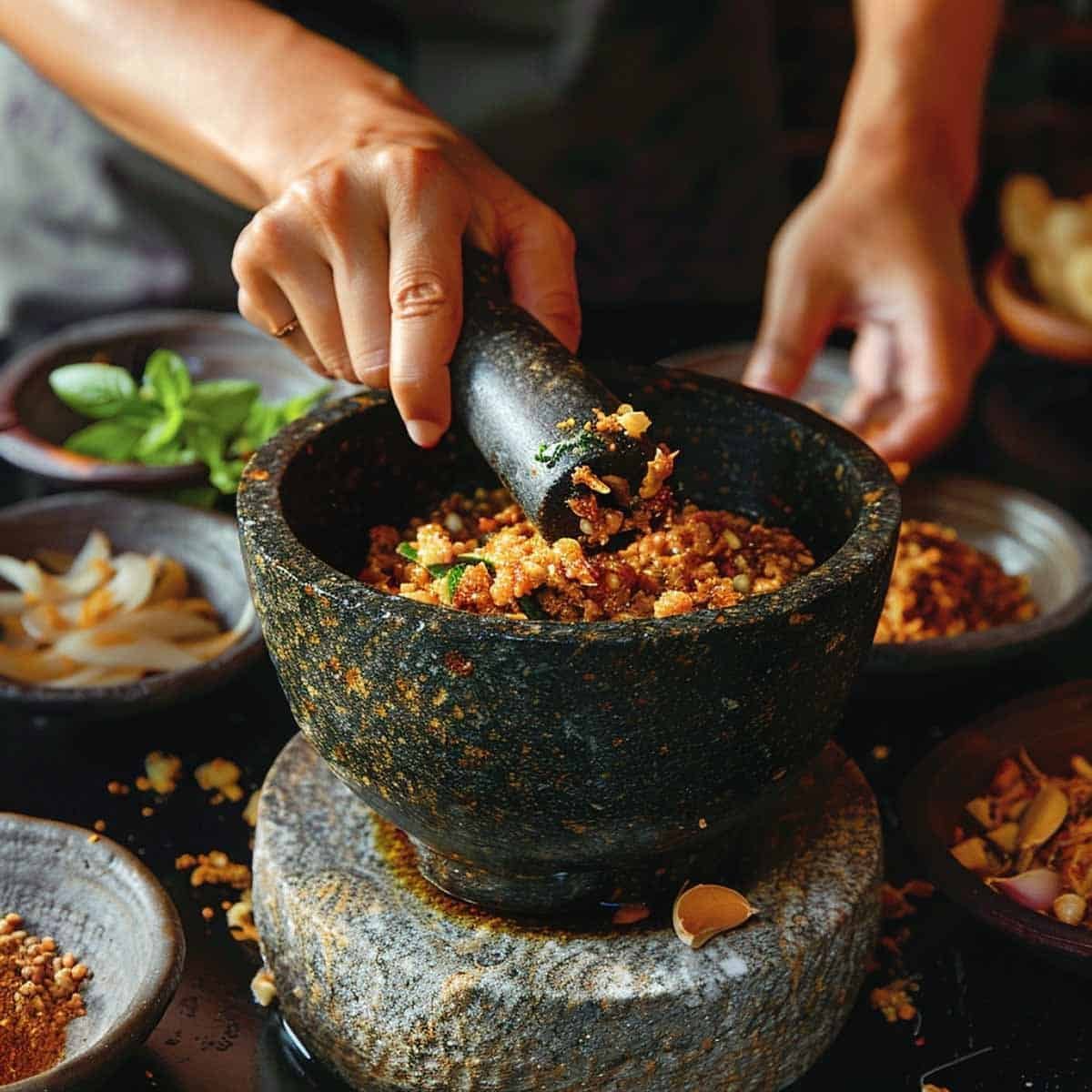
Cooking Thai Chili Paste.
Cooking the paste is a crucial step in making Thai chili paste. Therefore, gently simmer the blended mixture in the remaining oil over low heat, allowing the diverse flavors to meld seamlessly. As the paste cooks, keep an eye on it; you'll notice the oil starting to separate from the mixture.Consequently, this separation is a clear sign that the flavors have intensified, indicating that the paste is perfectly cooked and ready to elevate any dish with its robust taste.
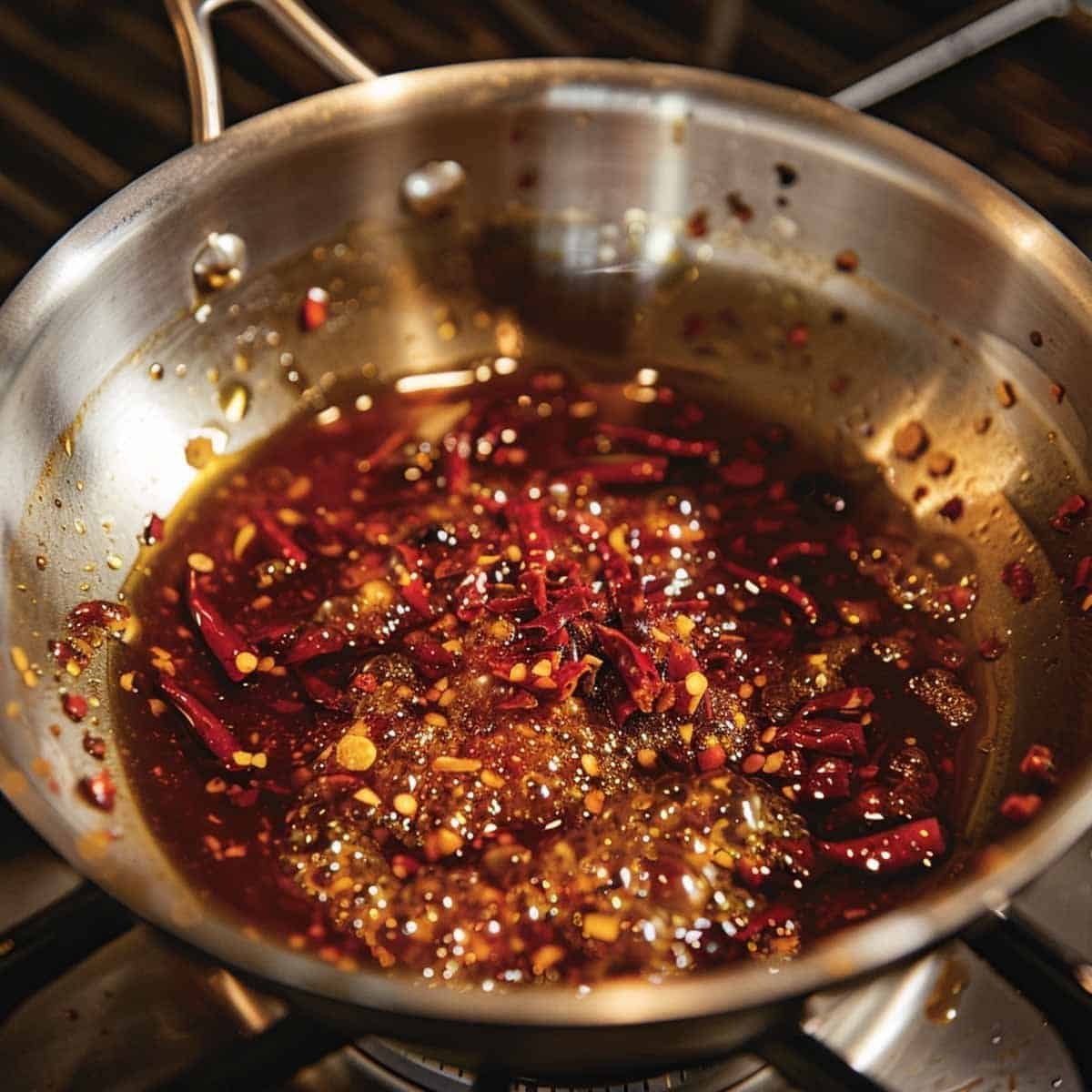
Cooling and Storing Nam Prik Pao :
Once your Nam Prik Pao is cooked, let it cool completely before transferring it to a clean jar. This cooling process helps the flavors to settle and mingle further, ensuring a consistent taste throughout the paste. Store the jar in the refrigerator where it will keep well for several weeks, ready to add a delightful burst of Thai flavors to your dishes whenever needed. Proper storage not only preserves the paste but also allows the flavors to deepen over time, enhancing its overall richness.
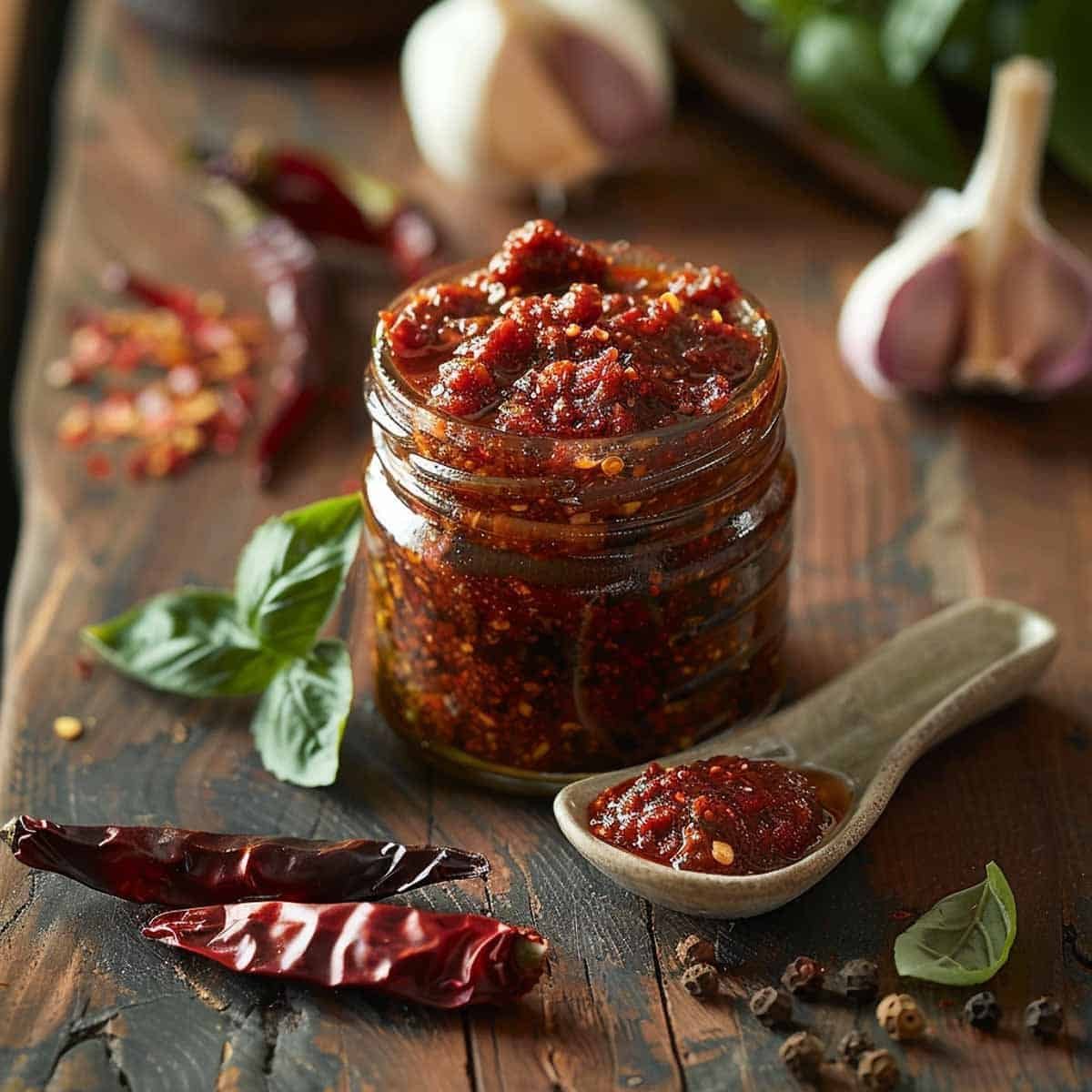

Nam Prik Pao (Thai roasted chili paste)
Ingredients
- 1 cup dried red chilies deseeded and soaked
- ½ cup shallots chopped
- ¼ cup garlic minced
- ¼ cup shrimp paste
- ½ cup palm sugar grated
- ¼ cup tamarind paste
- ¼ cup fish sauce
- ½ cup vegetable oil
Instructions
- Prepare the Chilies: Begin by draining the soaked red chilies, ensuring they are thoroughly dried. Heat a heavy-bottomed pan over medium heat and dry-roast the chilies until they become fragrant, stirring frequently to prevent burning. Remove from heat and set aside to cool.
- Roast Shallots and Garlic: In the same pan used for the chilies, dry-roast the chopped shallots and minced garlic until they turn golden brown and emit a rich, aromatic fragrance. This step enhances their natural sweetness and depth of flavor. Remove from the pan and set aside.
- Combine Ingredients: Transfer the cooled roasted chilies, shallots, and garlic into a food processor or blender. Add shrimp paste to the mixture. Blend on high until a smooth paste forms, scraping down the sides as needed to ensure even blending.
- Cook the Paste: Heat vegetable oil in a clean pan over medium heat. Add the blended chili paste mixture and fry until it becomes aromatic, stirring constantly to prevent burning. This step helps release the flavors and aromas of the ingredients.
- Add Seasonings: Once the paste is fragrant, stir in grated palm sugar, tamarind paste, and fish sauce. Allow the mixture to simmer gently, stirring occasionally, until it thickens to a paste-like consistency. Adjust seasoning to taste.
- Cool and Store: Remove the pan from heat and let the Nam Prik Pao paste cool to room temperature. Transfer it into sterilized jars or airtight containers, ensuring they are tightly sealed. Refrigerate the paste to maintain its freshness and flavors for up to 2 weeks.
Notes
Nutrition
FREQUENTLY ASKED QUESTIONS NAM PRIK PAO
Nam Prik Pao, also known as Thai roasted chili paste, is a versatile condiment made from a blend of roasted chilies, shallots, garlic, fish sauce, tamarind paste, shrimp paste, and palm sugar. It offers a complex flavor profile that is spicy, sweet, and tangy, making it a popular addition to various Thai dishes.
Nam Prik Pao can be used in several ways. It's commonly used as a spread on bread or crackers, as a dip for fresh or steamed vegetables, and as a flavor enhancer in soups, stir-fries, and noodle dishes. Additionally, it adds a rich, umami flavor with a hint of heat to any dish.
The spiciness of Nam Prik Pao can vary; specifically, it depends on the amount and type of chilies used. You can adjust the recipe to suit your heat preference by either increasing or decreasing the number of dried Thai chilies. When prepared, it typically offers a moderate heat level, which is well balanced with its other savory and sweet flavors.
If palm sugar is unavailable, you can substitute it with brown sugar or coconut sugar, which provide a similar depth of sweetness. The unique flavor of palm sugar is ideal, but these substitutes can work well and still deliver a good balance of flavors in the paste.
The choice of chili can significantly affect the flavor and heat level of Chili Paste. Typically, dried Thai chilies are used for their authentic flavor and manageable heat. However, for a milder version, you can use fewer chilies or substitute them with milder varieties like dried Anaheim or Guajillo chilies.
Using Authentic Ingredients
Sourcing quality ingredients is essential to achieve an authentic and flavorful Nam Prik Pao. Start with dried Thai red chilies, known for their robust heat and distinct flavor profile. Look for shrimp paste made from fermented shrimp, which adds a deep umami richness. Fresh shallots and garlic should be used for their aromatic sweetness when roasted. Opt for palm sugar, traditionally used in Thai cuisine, for its mellow sweetness and caramel-like notes. Tamarind paste, made from tamarind fruit pulp, brings a tangy, slightly sour element that balances the dish. Finally, fish sauce, a staple in Southeast Asian cooking, enhances the savory depth of the chili paste. By selecting these authentic ingredients, you'll capture the true essence of Thai flavors and create a Nam Prik Pao that resonates with traditional Thai cooking.
Adjusting Spiciness and Flavors
Customizing the spiciness and flavors of Nam Prik Pao allows you to tailor the condiment to your preference. To increase spiciness, add more dried red chilies during preparation. Adjust the heat level by including seeds from the chilies containing most of their heat. Reduce the number of chilies used or deseed them for a milder version. Balance the heat with additional palm sugar for sweetness or more fish sauce for umami richness. To enhance the smoky flavor, prolong the roasting time of the chilies and aromatics. Experiment with different brands of shrimp paste to find one that suits your taste, as they can vary in intensity. Taste and adjust the seasoning throughout the cooking process, ensuring the final paste reflects your desired spiciness and flavor complexity.
Substitutions
Several substitutions can be made in Nam Prik Pao for dietary needs or ingredient preferences without compromising its essence. Substitute dried Thai red chilies with milder varieties like guajillo or New Mexico for less heat. Use soy sauce instead of fish sauce for a vegetarian version, adjusting the quantity to taste. Coconut sugar can replace palm sugar as a lower glycemic index alternative. For a vegan option, omit shrimp paste or use a small miso paste for umami. Additionally, shallots can be replaced with red onions and garlic with garlic powder if fresh ingredients are unavailable. These substitutions allow flexibility while maintaining the core flavors and versatility of Nam Prik Pao.
Alternative Garnishes
Enhance your Nam Prik Pao with alternative garnishes that add texture and freshness. Try topping dishes with chopped roasted peanuts for a crunchy contrast to the paste's rich flavors. Fresh cilantro or Thai basil leaves bring a herbaceous note that complements the spicy-sweet profile. Sliced green onions or scallions provide a mild onion flavor and vibrant color. For added complexity, sprinkle toasted sesame seeds or crushed toasted rice over your dish. These garnishes enhance the visual appeal and add layers of flavor that harmonize with the depth of Nam Prik Pao, offering a customizable finishing touch to various culinary creations.
How to Serve
Nam Prik Pao is incredibly versatile and can be served in various ways to enhance your culinary creations. Use it as a flavor-packed dip for fresh vegetables or crispy spring rolls, allowing its rich flavors to complement the crunchiness of the snacks. Incorporate it into stir-fries, noodle dishes, or fried rice to impart a depth of smoky heat and umami richness. Spread it on grilled meats or seafood as a marinade or finishing sauce, adding a bold Thai twist to your barbecue. Mix it into soups and curries to intensify their flavors and create a hearty, warming meal. Whether as a condiment, ingredient, or standalone dip, Nam Prik Pao brings an authentic taste of Thailand to any dish, inviting you to explore its versatile uses in your kitchen adventures.
Reheating Options
To reheat Nam Prik Pao, scoop out the desired amount from the refrigerator and gently heat in a small saucepan over low to medium heat. Stir occasionally to prevent burning or sticking, allowing the chili paste to warm up slowly. Alternatively, microwave in short intervals, stirring in between, until heated through. Avoid overheating to preserve its flavors and texture. Once warmed, use immediately as a dip, sauce, or ingredient in your favorite dishes. Nam Prik Pao's robust flavors intensify with gentle reheating, ensuring each serving maintains its aromatic complexity and spicy kick.
Make-Ahead and Storage
Nam Prik Pao can be made ahead of time and stored for future use, making it a convenient addition to your meal prep routine. After preparing the chili paste, allow it to cool completely before transferring it to sterilized jars or airtight containers. Seal tightly and refrigerate for up to 2 weeks for optimal freshness. For longer storage, freeze portions of Nam Prik Pao in freezer-safe containers or ice cube trays. Thaw in the refrigerator overnight or gently heat from frozen on the stove. Before use, taste and adjust seasoning as needed to refresh the flavors. Whether stored in the fridge or freezer, Nam Prik Pao retains its bold flavors and versatility, ready to elevate your dishes whenever inspiration strikes.
Required Kitchen Equipment:
Food Processor: The food processor is indispensable for creating Nam Prik Pao. It effectively blends roasted chilies, garlic, and shallots into a velvety paste. This ensures a consistent texture that enhances the paste's overall flavor profile, allowing each ingredient to harmonize seamlessly.
Heavy-bottomed Pan: Used for dry-roasting chilies, shallots, and garlic, the heavy-bottomed pan distributes heat evenly. This gentle roasting process intensifies their natural flavors and aromas, imparting a deep, smoky essence crucial to the complex taste of Nam Prik Pao.
Saucepan: An essential tool for heating vegetable oil and simmering the chili paste mixture, the saucepan facilitates the development of depth and aroma. This step allows the ingredients to meld together while reducing and intensifying their flavors, resulting in a rich, concentrated paste.
Sterilized Jars or Airtight Containers: Vital for preserving Nam Prik Pao's freshness and flavor, sterilized jars or airtight containers ensure optimal storage conditions. Proper sealing prevents air exposure, maintaining the paste's vibrant taste and extending its shelf life in the refrigerator.
Tasting Notes:
Visual: Nam Prik Pao boasts a deep, earthy red color, gleaming with a glossy sheen of oil and specks of charred chili and garlic, promising a robust flavor experience.
Aroma: The aroma is irresistibly aromatic, with notes of smoky roasted chilies that mingle harmoniously with the sweet, caramelized essence of shallots. A subtle undertone of pungent shrimp paste adds depth and complexity to its bouquet.
Taste: When savored, Nam Prik Pao reveals a symphony of flavors—a bold, smoky heat from the chilies balanced by the delicate sweetness of palm sugar. Adding shrimp paste and fish sauce brings layers of umami, enhancing the overall savory profile with a lingering richness.
Texture: Its texture is luxuriously smooth yet delicately grainy, owing to finely ground roasted oil-constrained ingredients. This consistency ensures a delightful mouthfeel, coating the palate with each savory spoonful.

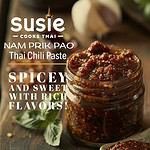

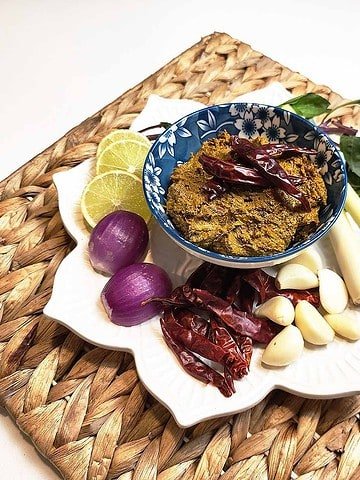
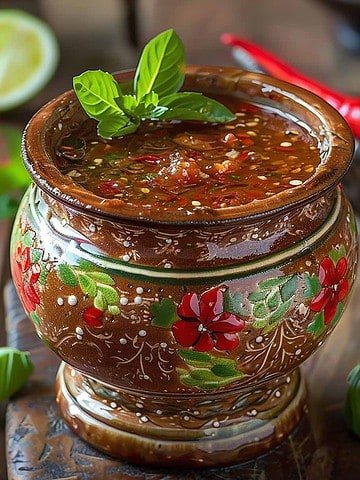
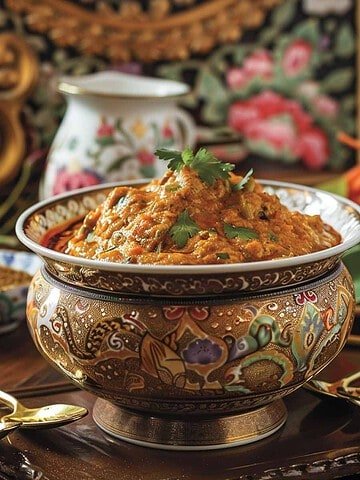
Leave a Reply